Schemes and knitting patterns on children's things may differ in appearance compared to things for adults. These may be patterns that look too frivolous on ordinary things. Sometimes craftswomen specifically come up with a repeating pattern on children's things that is associated with something cheerful, cute and naive (houses, animals, flowers, etc.).
Necessary tools and materials
Before starting to knit a product, it is carefully thought out - its size, model. They also think about what texture the product will have and what pattern - this is affected by the type of yarn and the size of the knitting needles for it.
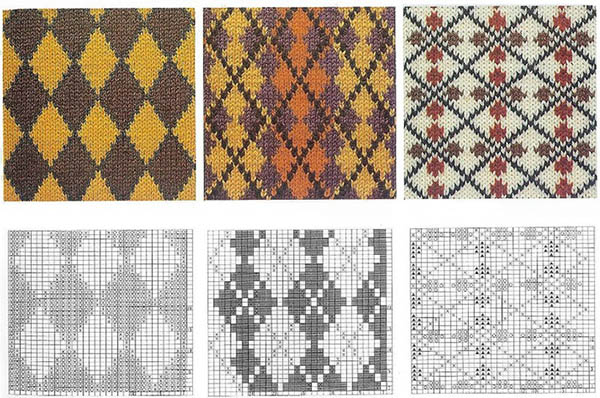
Tips on selecting tools and materials.
- The width of the knitting needle should be 2 times thicker than the yarn. Most often, the yarn manufacturer indicates on the packaging the recommendations for the number of knitting needles for the work. If the knitter has enough experience, she already selects the knitting needles for her work herself. She can take knitting needles of a smaller diameter so that the product holds its shape better or of a larger diameter to create a more airy shape.
- Plastic or bamboo needles are chosen for working with soft yarn. Aluminum needles are recommended for working with dark-colored yarn, since this metal and its alloys can leave a gray mark on the threads.
- Before buying, inspect the knitting needles to ensure there are no nicks or scratches. If you choose knitting needles with a fishing line, the joints should be tight, otherwise the thread or knitting fabric will catch during work.
- Calculate the number of knitting needles needed for the work. For knitting a smooth and straight fabric, 2 knitting needles are enough. If the work is done in a circle, then 5 knitting needles may be needed.
- To calculate yarn consumption, pay attention to the information on the skein packaging. The longer the thread length in 100 g, the thinner it is. Accordingly, the consumption of such yarn will be higher.
Particular attention is paid to the selection of yarn based on its composition.
It can be natural or synthetic, and each type has its own advantages and disadvantages:
| Type of yarn | Varieties | Description |
| Natural | Alpaca | Thick and warm llama wool. Most often found in a mixed form with acrylic and merino due to its high cost. Warms in the cold and cools in the heat. |
| Angora | Soft and warm rabbit down. The products last a long time, but the down quickly falls out. The products can only be washed in dry cleaning. | |
| Cashmere | Soft and warm down of mountain goats, pleasant to the touch. Products made from yarn are smooth, easy to care for, non-prickly and hypoallergenic. Products quickly become covered with pellets. The yarn can only be hand-dyed. | |
| Flax | Durable, antibacterial, retains heat and absorbs moisture. Products made from this yarn are easy to care for, they do not deform, but they wrinkle a lot and have a rough appearance. The yarn is poorly dyed and lightened, so the color palette is often presented in beige tones. | |
| Merino | Warm yarn from sheep wool, hypoallergenic. Products serve for a long time, but require hand washing and careful care. | |
| Mohair | Fluffy yarn made from goat wool. Easy to clean and dye. Requires hand washing. | |
| Cotton | Vegetable yarn that is breathable and moisture-absorbing. Hypoallergenic, almost does not fade, stronger than wool, but less durable than linen or silk and does not retain heat well. Does not stretch. | |
| Silk | Durable, absorbs moisture well, retains heat. The products almost do not form pellets, but they cannot be washed. | |
| Synthetic | Acrylic | The products do not lose their color brightness, retain heat and do not lose their shape. The yarn is pleasant to the touch. It is convenient to use for beginners and for machine knitting. It absorbs moisture poorly, so it has a low hygiene rating. |
| Viscose | Added to natural types of yarn to obtain bright and hygienic compositions that do not electrify. May be deformed with frequent spinning of washing. | |
| Lurex | Adding shiny metallic threads allows you to decorate the appearance of the product. It is prickly to the touch, requires adding a lining to the product. Does not tolerate washing well. |
Schemes for beginners
Knitting patterns and designs with detailed descriptions are needed when there is little experience or you are not sure of the correct interpretation of the system. Knitters often make classic patterns for decorating clothes, hats or home accessories. Children's patterns are used less often, so it is better to follow the description so that the pattern turns out without errors.
Openwork
Knitting pattern (diagrams and explanations are given below) in the form of openwork flowers is suitable for creating children's summer clothes. The example shows a fragment made with cotton threads with the addition of acrylic. If desired, they can be replaced with any others. Making a pattern with fluffy threads on thick knitting needles will give additional lightness to the texture of the fabric.
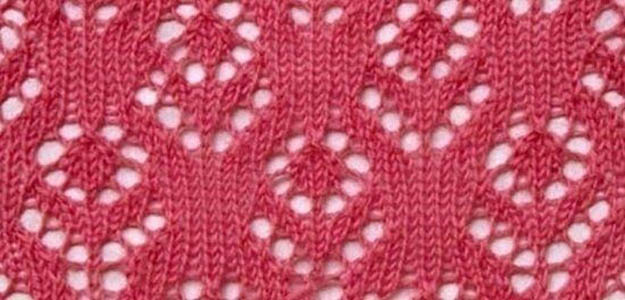
In the description, all elements are indicated by initial letters (front loop - LP, back loop - IP, yarn over - H, draw through - P, double draw through - DP). In this pattern, draw through is done by slipping the loop as a front loop, making 1 front loop and pulling it through the slipped loop. Double draw through in this pattern is when you knit 2 front loops at once and pull this loop through the slipped loop.

The pattern is repeated every 12 loops, so the initial row is cast on in the classic way, where the number of loops is a multiple of 12.
All even rows are knitted.
| Row | Description |
| 1 | 4LP, 1P, 1N, 1LP, 1N, 2LP to the right, 7LP, 1P, 1H, 1LP, 1N, 2LP to the right, 4LP. |
| 3 | 3LP, 1P, 1N, 3LP, 1N, 2LP right, 5LP, 1P, 1N, 3LP, 1N, 2LP right, 3LP. |
| 5 | 2 LP, 1 R, 1 H, 5 LP, 1 H, 2 LP to the right, 3 LP, 1 R, 1 H, 5 LP, 1 H, 2 LP to the right, 2 LP. |
| 7 | 4 LP, 1 R, 1 N, 1 LP, 1 N, 2 LP to the right, 7 LP, 1 R, 1 H, 1 LP, 1 N, 2 LP to the right, 4 LP. |
| 9 | 3LP, 1P, 1N, 3LP, 1N, 2LP right, 5LP, 1P, 1N, 3LP, 1N, 2LP right, 3LP. |
| 11 | 4LP, 1H, 1P, 1LP, 2LP to the right, 1H, 7LP, 1N, 1P, 1LP, 2LP to the right, 1H, 4LP. |
| 13 | 1LP, 1H, 2LP to the right, 2LP, 1H, DP, 1H, 2LP, 1P, 1H, 1LP, 1H, 2LP to the right, 2LP, 1H, DP, 1H, 2LP, 1P, 1H, 1LP. |
| 15 | 2LP, 1N, 2LP right, 5LP, 1R, 1N, 3LP, 1N, 2LP right, 5LP, 1R, 1N, 2LP. |
| 17 | 3LP, 1N, 2LP right, 3LP, 1P, 1N, 5LP, 1N, 2LP right, 3LP, 1P, 1N, 3LP. |
| 19 | 1LP, 1H, 2LP to the right, 7LP, 1P, 1H, 1LP, 1H, 2LP to the right, 7LP, 1P, 1H, 1LP. |
| 21 | 2LP, 1N, 2LP right, 5LP, 1P, 1N, 3LP, 1N, 2LP right, 5LP, 1P, 1N, 2LP. |
| 23 | 1 LP, 2 LP to the right, 1H, 7 LP, 1H, 1 R, 1 LP, 2 LP to the right, 1 H, 7 LP, 1 H, 1 R, 1 LP. |
| 25 | 2 LP to the right, 1H, 2 LP, 1P, 1H, 1 LP, 1N, 2 LP to the right, 2 LP, 1H, 2 LP to the right, 2 LP, 1H, DP, 1H, 2 LP, 1P, 1N, 1 LP, 1H, 2 LP to the right, 2 LP, 1H, 1P. |
Butterflies
The butterfly pattern is repeated every 31 loops, it is repeated in a checkerboard pattern or symmetrically on the sides of the product. The initial row is cast on in the classic way, the number of loops is a multiple of 31 and 2 side loops.

In the description, all elements are indicated by initial letters (yarn over - H, 2 together knitwise with a tilt to the right - ЛВп, 2 together knitwise with a tilt to the left - ЛВл, purl loop - И, knit loop - Л, 3 loops together knitwise - Л3).
The order of execution of rows.
- 1L, LVp, 2H, LVl, 19L, LVp, 2H, LVl, 2L.
- 3L, 1I, 22L, 1I, 4L.
- 5L, 1H, LVl, 17L, LVp, 1H, 5L.
- All L.
- 6L, 1H, LVl, 15L, LVp, 1H, 6L.
- 7L, 1H, LVl, 13L, LVp, 1H, 7L.
- 5L, LVp, 1H, 1L, 1H, LVl, 11L, LVp, 1H, 1L, 1N, LVl, 5L.
- 4L, LVp, 1H, 3L, 1H, LVl, 9L, LVp, 1H, 3L, 1N, LVl, 4L.
- 3L, LVp, 1H, 5L, 1H, LVl, 3L, 1N, LVl, 2L, LVp, 1H, 5L, 1N, LVl, 3L.
- All L.
- 2L, LVp, 1H, LVp, 2N, LVl, 2L, 1N, LVl, LVp, 1H, 1L, 1H, LVl, LVp, 1H, 2L, LVp, 2N, LVl, 1L, 1H, LVl, 2L.
- 6L, 1I, 16L, 1I, 7L.
- 1L, LVp, 1H, 1L, LVp, 1H, 2L, 1H, LVl, 2L, 1H, LVl, 1N, L3, 1H, LVp, 1H, 2L, LVp, 1H, LVp, 1H, 2L, 1H, LVl, 1L, 1H, LVl, 1L.
- All L.
- 3L, N, LVl, 9L, 1H, L3, 1H, 9L, LVp, 1H, 3L.
- 4L, 1H, LVl, 19L, LVp, 1H, 4L.
- 2L, LVp, 1H, 3L, 1N, LVl, 5L, 1N, L3, 1N, 5L, LVp, 1N, 3L, 1N, LVl, 2L.
- All L.
- 1L, LVp, 1N, 2L, LVp, 1N, 1L, 1N, LVl, 4L, 1N, L3, 1N, 4L, LVp, 1N, 1L, 1N, LVl, 2L, 1n, LVl, 1L.
- All L.
- LVp, 1H, 2L, LVp, 1H, 3L, 1N, LVl, 1H, LVl, 1H, 3L, 1H, LVl, 1L, LVl, 1N, 3L, 1H, LVl, 2L, 1H, LVl.
- All L.
- 2L, 1H, LVL, 2L, 1H, L3, 1H, 2L, LVp, 1H, 1L, 1H, L3, 1H, 1L, 1N, LVL, 2L, 1H, L3, 1H, 2L, LVp, 1H, 2L.
- All L.
- 3L, 1H, LVl, 2L, 1H, LVl, 1L, LVp, 1H, 7L, 1N, LVl, 1L, LVl, 1N, 2L, LVp, 1H, 3L.
- 9L, LVl, 1H, 9L, 1H, LVl, 9L.
- 4L, 1H, LVl, 2L, LVp, 1N, 11L, 1N, 1LVl, LVp, 1H, 4L.
- 7L, LVl, 1H, 13L, 1H, LVl, 7L.
- 6L, L3, 1N, 15L, 1N, L3, 6L.
- 5L, LVl, 1H, 17L, 1H, LVl, 5L.
Heart
The knitting pattern (the patterns have different interpretations, so it is better to read the description for a better understanding) in the form of hearts consists of a “double eyes” element repeated in rows.
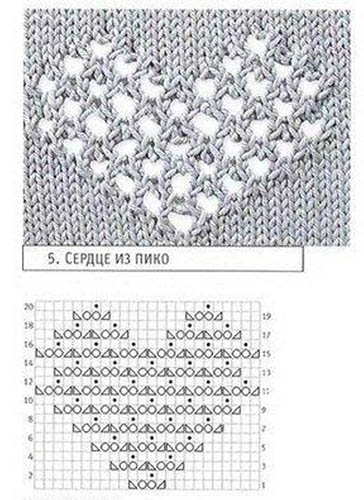
In the description, all elements and loops are indicated by initial letters (2 loops knitted together with a tilt to the right - ЛВп, 2 loops knitted together with a tilt to the left - ЛВл, 2 yarn overs in the purl row knit 1 knit loop, 1 purl - НЛИ, knit loop - Л, purl loop - И, yarn over knitted in the purl row as a knit loop - НЛ). The pattern is repeated every 24 loops.
The initial row is cast on in the classical way.
Algorithm for performing a pattern row by row.
- 10L, LVp, NLI, LVl, 10L.
- 11I, NL, 12I.
- 8L, LVp, NLI, LVl, LVp, NLI, LVl, 8L.
- 9I, NL, 3I, NL, 10I.
- 6L, LVp, NLI, LVl, LVp, NLI, LVl, LVp, NLI, LVl, 6L.
- 7I, NL, 3I, NL, 3I, NL, 8I.
- 4L, LVp, NLI, LVl, LVp, NLI, LVl, LVp, NLI, LVl, LVp, NLI, LVl, 4L.
- 5I, NL, 3I, NL, 3I, NL, 3I, NL, 6I.
- 2L, LVp, NLI, LVl, LVp, NLI, LVl, NLI, LVl, LVL, NLI, LVl, LVP, NLI, LVl, 2L.
- 3I, NL, 3I, NL, 3I, NL, 3I, NL, 3I, NL, 4I.
- LVp, NLI, LVl, LVp, NLI, LVl, LVp, NLI, LVl, LVp, NLI, LVl, LVp, NLI, LVl, LVp, NLI, LVl.
- 1I, NL, 3I, NL, 3I, NL, 3I, NL, 3I, NL, 3I, NL, 2I.
- 2L, LVp, NLI, LVl, LVp, NLI, LVl, LVp, NLI, LVl, LVp, NLI, LVl, LVp, NLI, LVl, 2L.
- 3I, NL, 3I, NL, 3I, NL, 3I, NL, 3I, NL, 4I.
- LVp, NLI, LVl, LVp, NLI, LVl, LVp, NLI, LVl, LVp, NLI, LVl, LVp, NLI, LVl, LVp, NLI, LVl.
- 1I, NL, 3I, NL, 3I, NL, 3I, NL, 3I, NL, 3I, NL, 2I.
- 2L, LVp, NLI, LVl, LVp, NLI, LVl, 4L, LVp, NLI, LVl, LVp, NLI, LVl, 2L.
- 3I, NL, 3I, NL, 7I, NL, 3I, NL, 4I.
- 4L, LVp, NLI, LVl, 8L, LVp, NLI, LVl, 4L.
- 5I, NL, 11I, NL, 6I.
Cats
The cat head and whisker pattern is repeated every 20 stitches and 12 rows.
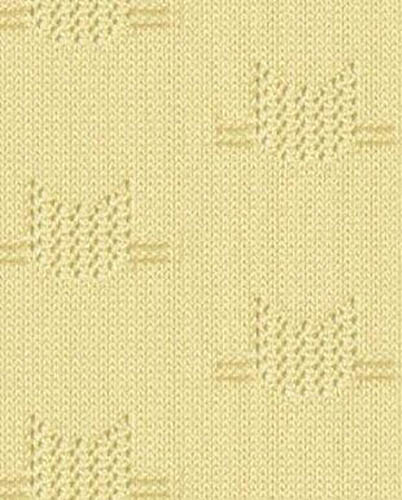
It is repeated in a checkerboard pattern or any other. In the description, all elements are indicated by initial letters (2 loops together front with a left tilt - ЛВл, 2 loops together front with a right tilt - ЛВп, yarn over - Н, front loop - Л, purl loop - И).
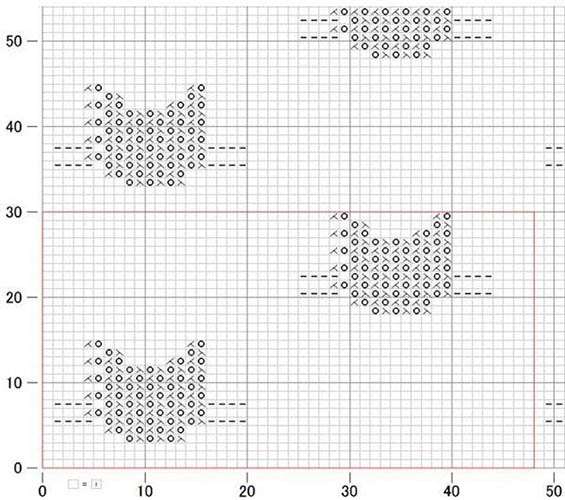
The row-by-row algorithm includes the following steps.
| Row | Description |
| 1 | 6L, LVl, H, LVl, H, LVl, H, 8L. |
| 2 | 6L, N, LVp, N, LVp, N, LVp, N, LVp, 6L. |
| 3, 5 | 4I, LVl, N, LVl, N, LVl, N, LVl, N, LVl, N, 1L, 4I, 1L. |
| 4, 6, 8 | 4L, N, LVp, N, LVp, N, LVp, N, LVp, N, LVp, N, LVp, 4L. |
| 7, 9 | 4L, LVl, H, LVl, H, LVl, H, LVl, H, LVl, H, 6L. |
| 10 | 4L, N, LVp, N, LVp, 4L, N, LVp, N, LVp, 4L. |
| 11 | 4L, LVl, H, 6L, LVl, H, 6L. |
| 12 | 4L, N, LVp, 8L, N, LVp, 4L. |
Christmas trees
Knitting pattern (patterns for children's clothes usually consist of one element, which is repeated in a checkerboard or random order) in the form of Christmas trees is repeated every 12 loops and 9 rows. All even rows are done with purl.
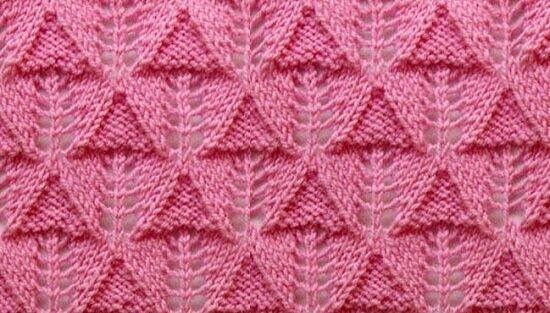
In the description, all elements are designated by initial letters (front loop - L, back loop - I, yarn over - H, draw through - P, double draw through - DP, 2 loops knitted together - PL). The draw through is done by slipping 1 loop as a front loop, knitting 1 front loop and pulling it through the slipped front loop.
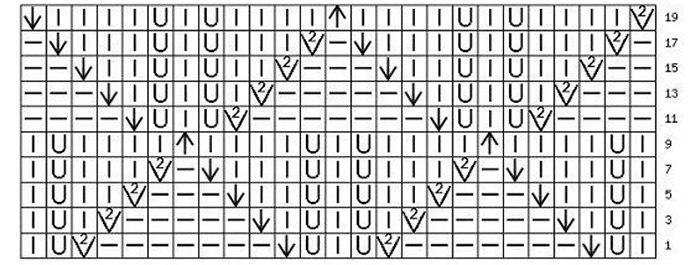
Double draw in this pattern is when you knit 2 front loops at once and draw this loop through the slipped loop.
The algorithm for rows is as follows.
| Row | Description |
| 1 | 1L, 1N, 1P, 7I, PL, 1N. |
| 3 | 1L, 1N, 1L, 1P, 5L, PL, 1L, 1N. |
| 5 | 1L, 1N, 2L, 1P, 3I, PL, 2L, 1N. |
| 7 | 1L, 1N, 3L, 1P, 1L, PL, 3L, 1N. |
| 9 | 1L, 1N, 4L, DP, 4L, 1N. |
Flowers
The openwork pattern in the form of flowers with 6 petals is performed in a checkerboard pattern. The pattern is repeated every 19 loops and 11 rows. All even rows are performed as purl.

In the description, all elements are designated by initial letters (front loop - L, yarn over - H, draw through - P, double draw through - DP, 2 loops knitted together - PL). Draw through is done by slipping 1 loop as a front loop, knitting 1 front loop and pulling it through the slipped front loop. Double draw through in this pattern is when you knit 2 front loops at once and pull this loop through the slipped loop.

The algorithm for rows is as follows.
| Row | Description |
| 1 | 1L, PL, 1N, 1L, 1N, 1P, 7L, PL, 1N, 1L, 1N, 1P, 1L. |
| 3 | PL, 1N, 3L, 1N, 1P, 5L, PL, 1N, 3L, 1N, 1P. |
| 5 | 2L, 1N, DP, 1N, 9L, 1N, DP, 1N, 2L. |
| 7 | 7L, PL, 1N, 1L, 1N, 1P, 7L. |
| 9 | 6L, PL, 1N, 3L, 1N, 1P, 6L. |
| 11 | 8L, 1N, DP, 1N, 8L. |
Houses
Knitting ornament (the patterns of most children's patterns are openwork and involve working with cotton, wool or acrylic threads) in the form of repeating houses is made in 15 loops and 21 rows. All even rows are made with purl.
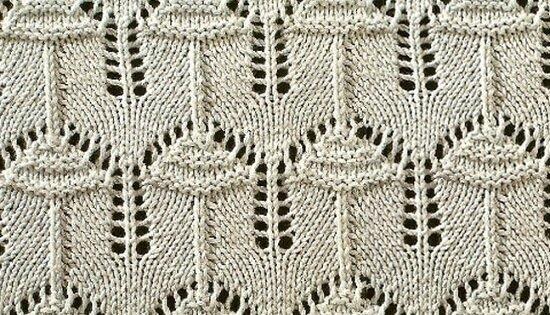
In the description, all elements are designated by initial letters (front loop - L, back loop - I, yarn over - H, draw through - P, 2 loops knitted together - PL, 2 loops knitted together - PI, 3 loops knitted together - 3PL).

The draw through is done by slipping 1 stitch as if it were a front stitch, knitting 1 front stitch and pulling it through the slipped front stitch. 3 stitches knitted together as front stitches in this pattern are done by slipping 2 stitches, knitting 1 front stitch and pulling it through the slipped 2 stitches.
The algorithm for rows is as follows.
| Row | Description |
| 1, 3, 7, 9 | 1L, 1N, 5L, 3PL, 5L, 1N, 1L. |
| 11 | 1L, 1N, PI, 9I, PI, 1N, 1L. |
| 13 | 2L, 1N, PL, 7L, P, 1N, 2L. |
| 15 | 3L, 1N, PI, 5I, PI, 1N, 3L. |
| 17 | 4L, 1N, PL, 3L, P, 1N, 4L. |
| 19 | 5L, 1N, PI, 1I, PI, 1N, 5L. |
| 21 | 6L, 1N, 3PL, 1N, 6L. |
Secrets for Beginners
- The yarn packaging always contains recommendations on the number of suitable knitting needles.
- The color of the yarn may differ even from one manufacturer, so it is better to take yarn with a reserve, but do not open all the skeins at once. Many stores can accept surplus yarn, provided that the packaging of the skein is intact.
- For the first time, it is recommended to work with simple yarn, gradually moving on to more complex compositions (fluffy or decorative thread) and ornaments. It is also better to first practice knitting a separate fragment of the pattern to understand how the pattern will look with this type of thread and determine whether there is enough yarn for the product.
- To prevent the threads from getting tangled during knitting, they are first rewound from skeins into balls.
- Using circular needles reduces the strain on your arms, shoulders and body while you work. They are also convenient for knitting items of any length.
- If straight knitting needles are used, then stoppers are put on their ends so that the loops do not fly off during work. Cork or other materials are used as a stopper. Many handicraft stores have knitting needles with ready-made stoppers.
- The cord on new circular needles can twist and make knitting difficult. To straighten the cord and make it softer, soak it in boiling water for a few minutes.
- It is recommended to use knitting needles that contrast in color with the selected yarn, so that the tool and thread do not merge. Also, a white sheet or fabric is placed under the knitting fabric if you are working with dark yarn, so that the pattern is visible. This will also allow you to carefully collect the yarn fluff that separates from the skein during work.
- To prevent the thread from tangling while knitting, use the end from the center of the skein or ball. Many people use auxiliary objects to prevent the ball or skein from jumping during unwinding. Craft stores have special devices for this. If you can't use one, use a teapot, jars with a paper clip, or a colander.
- In order not to get lost in the process of making a pattern, they keep records where they mark the rows made, increases and decreases, the number of loops. Many needlewomen start special notebooks where they indicate the article number of yarn and the number of knitting needles used for a certain product. They do this in order to quickly restore important information if necessary.
- If you need to knit paired parts (sleeves, etc.), it is recommended to do this on circular needles at the same time. This simplifies the knitting process, since you do not have to do the same work twice.
Knitting patterns and designs help you decide on a suitable pattern for a product and quickly complete it, using a ready-made algorithm. If you follow the advice of experienced knitters, the work process will become even faster and the product will be of good quality the first time.
Video about knitting
Greek ornament: mosaic knitting:
